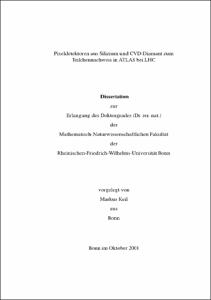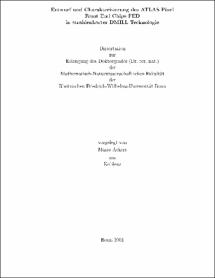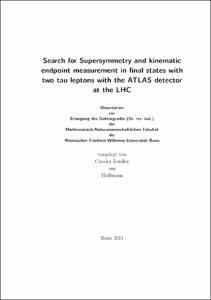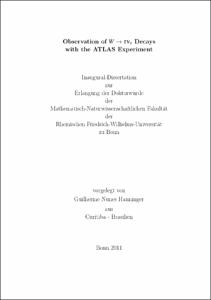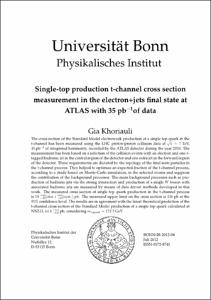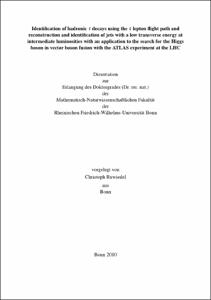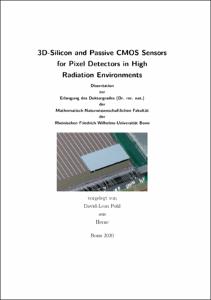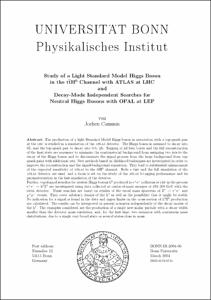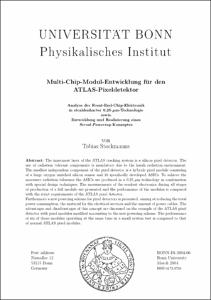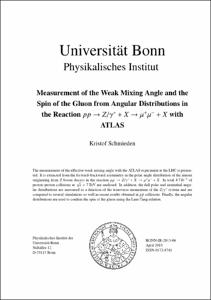E-Dissertationen: Search
Now showing items 1-10 of 34
Pixeldetektoren aus Silizium und CVD-Diamant zum Teilchennachweis in ATLAS bei LHC
(2001)
The ATLAS experiment at the future Large Hadron Collider at CERN uses a silicon pixel detector as the innermost tracking device. Measurements characterising the prototype ATLAS pixel readout chip FE-A/C are described and ...
Entwurf und Charakterisierung des ATLAS Pixel Front End Chips FED in strahlenharter DMILL Technologie
(2001)
Der Entwurf und die Charakterisierung des Auslesechips FED für den ATLAS Pixeldetektor in der strahlenharten DMILL Technologie werden in dieser Arbeit beschrieben. Bei einer Ereignisrate von 40 MHz und einer totalen ...
Search for Supersymmetry and kinematic endpoint measurement in final states with two tau leptons with the ATLAS detector at the LHC
(2011-10-21)
Discovery prospects for Supersymmetry in final states with at least two tau leptons and large missing transverse energy are evaluated for LHC proton-proton collisions measured with the ATLAS detector. In a first study based ......
Das Entdeckungspotential von Supersymmetrie mit Endzust¨anden aus mindesten zwei Tau Leptonen und fehlender Transversalenergie in Proton-Proton Kollisionen wird untersucht, sowie die M¨oglichkeit einer Messung des Endpunktes ......
Das Entdeckungspotential von Supersymmetrie mit Endzust¨anden aus mindesten zwei Tau Leptonen und fehlender Transversalenergie in Proton-Proton Kollisionen wird untersucht, sowie die M¨oglichkeit einer Messung des Endpunktes ......
Observation of W → τντ Decays with the ATLAS Experiment
(2011-05-04)
Physics studies of processes with t leptons in the final state, while challenging at hadron colliders, are of great importance at the LHC. The τ leptons provide important signatures in searches for the Higgs boson as well ......
Single-top production t-channel cross section measurement in the electron+jets final state at ATLAS with 35 pb-1 of data
(2012-09-03)
The cross section of the Standard Model electroweak production of a single top quark in the t-channel has been measured using the LHC proton-proton collision data at $sqrt{s}=7$ TeV, $35 {\rm pb}^{-1}$ of integrated ...
Identification of hadronic τ decays using the τ lepton flight path and reconstruction and identification of jets with a low transverse energy at intermediate luminosities with an application to the search for the Higgs boson in vector boson fusion with the ATLAS experiment at the LHC
(2010-07-01)
Three studies of different components of the object reconstruction with the ATLAS experiment using simulated data are presented. In each study, a method for the improvement of the reconstruction is developed and the ...
3D-Silicon and Passive CMOS Sensors for Pixel Detectors in High Radiation Environments
(2020-10-30)
The future upgrade of the Large Hadron Collider to the High-Luminosity LHC demands new pixel detectors that can operate in environments with exceptionally high radiation. This requires investigations into new radiation-tolerant ...
Study of a Light Standard Model Higgs Boson in the t¯tH0 Channel with ATLAS at LHC and Decay-Mode Independent Searches for Neutral Higgs Bosons with OPAL at LEP
(2004)
The production of a light Standard Model Higgs boson in association with a top-quark pair at the LHC is studied in a simulation of the ATLAS detector. The Higgs boson is assumed to decay into bb, and the top-quark pair to ......
Multi-Chip-Modul-Entwicklung für den ATLAS-Pixeldetektor: Analyse der Front-End-Chip-Elektronik in strahlenharter 0,25-µm-Technologie sowie Entwicklung und Realisierung eines Serial-Powering-Konzeptes
(2004)
The innermost layer of the ATLAS tracking system is a silicon pixel detector. The use of radiation tolerant components is mandatory due to the harsh radiation environment. The smallest independent component of the pixel ...
Measurement of the Weak Mixing Angle and the Spin of the Gluon from Angular Distributions in the Reaction pp → Z/γ* + X → μ+μ- + X with ATLAS
(2013-11-15)
The measurement of the effective weak mixing angle with the ATLAS experiment at the LHC is presented. It is extracted from the forward--backward asymmetry in the polar angle distribution of the muons originating from $Z$ ...


